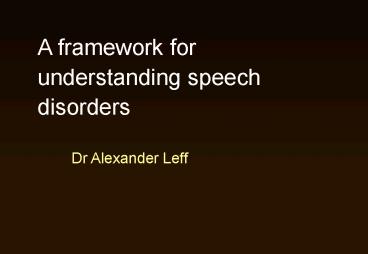A framework for understanding speech disorders - PowerPoint PPT Presentation
1 / 30
Title:
A framework for understanding speech disorders
Description:
Articulatory: Speech apraxia, dysarthria, dysphonia, (only a problem when speaking) ... All aphasic patients have a problem with speech production (errors vary) ... – PowerPoint PPT presentation
Number of Views:88
Avg rating:3.0/5.0
Title: A framework for understanding speech disorders
1
A framework for understanding speech
disorders Dr Alexander Leff
2
- Plan
- Minimal anatomical and linguistic theory
- Clinical examination of language function
- Errors to look out for
- Clinical cases (videos and scans)
3
Anatomy boxes and sticks
Wernicke-Lichtheim model (1874) Popularized by
Geschwind (1970, 1985) Connectionism A
auditory language area M motor language area B
concept area (ideation)
4
Transcortical Motor aphasia
Transcortical Sensory aphasia
Wernickes aphasia
Brocas aphasia
Conduction aphasia
Pure word deafness
Speech apraxia
5
Boxes and sticks projected onto the brain
6
Processes involved in speaking
Concept generation and retrieval of its
representation
Phonology and articulation
7
Processes involved in speaking
Aphasia (present regardless of output mode)
Articulatory Speech apraxia, dysarthria,
dysphonia, (only a problem when speaking)
8
- Nomenclature
- Broca output motor production.
- Wernicke input sensory perception.
- All aphasic patients have a problem with speech
production (errors vary). - Even Broca-type patient have problems
- comprehending complex sentences.
9
Examination
- Speech output
- Spontaneous/picture description
- Naming
- Repetition
- Automatic (counting)
- Auditory input
- 1st, 2nd and 3rd order commands
- Writing
- Reading
10
What to look for
- Speech output
- Volume (high, normal or low).
- Agrammatic/telegraphic (function words missing).
- Meaningful (semantic content)?
- Speech error types
- Phonemic (cat ? cap)
- Semantic (cat ? dog)
- Jargon (cat ? ???)
- Visual errors
- Perseverations
11
(No Transcript)
12
Cases
13
Case A Video
14
Case A
15
Case B
Cognitive ? gestural object use (limb
apraxia) Digit span ? 3 Naming ? (semantic
errors) Repetition ? Comprehension ? (SW and
complex sentences) Writing ? Reading ?
16
Case B Video I Video II
17
Case B
L
18
Case C Video
19
Case C
Cognitive normal Digit span normal
5 Naming mildly ? Repetition mod ? (OK for
non-words) Comprehension mildly ? at sentence
level Writing normal Reading normal
20
Case C
L
21
Case D Video
22
Case D
Cognitive normal Digit span 7 Naming mildly
impaired Repetition ?? Comprehension slow
but correct Writing ? left school
early Reading ? left school early
23
Case D
L
1. Left SLF
2. Right MCP
3. Left post insula
24
Case E Video
25
Case E
Cognitive ? gestural object use Digit span 6
(normal) Naming ?? v. poor (sem and phon
errors) Repetition ? poor Comprehension ? at
sentence level Writing ? mild (picture
description) Reading ? all word types,
especially non-words
26
Case E
L
27
Case F Video
28
Case F
Cognitive normal Digit span 7
(normal) Naming normal Repetition normal Compr
ehension normal Writing normal Reading ? mild
29
Case F
30
- Conclusions
- Language testing is not difficult
- Why is it hard to predict lesion site from
behaviour? - Input and output classification is a
misnomer - Clinically and experimentally not enough
emphasis on error types - Wernicke-Lichtheim model has its uses
- More so for behaviour than brain models of
language - Look out for more complex lesion overlap maps































